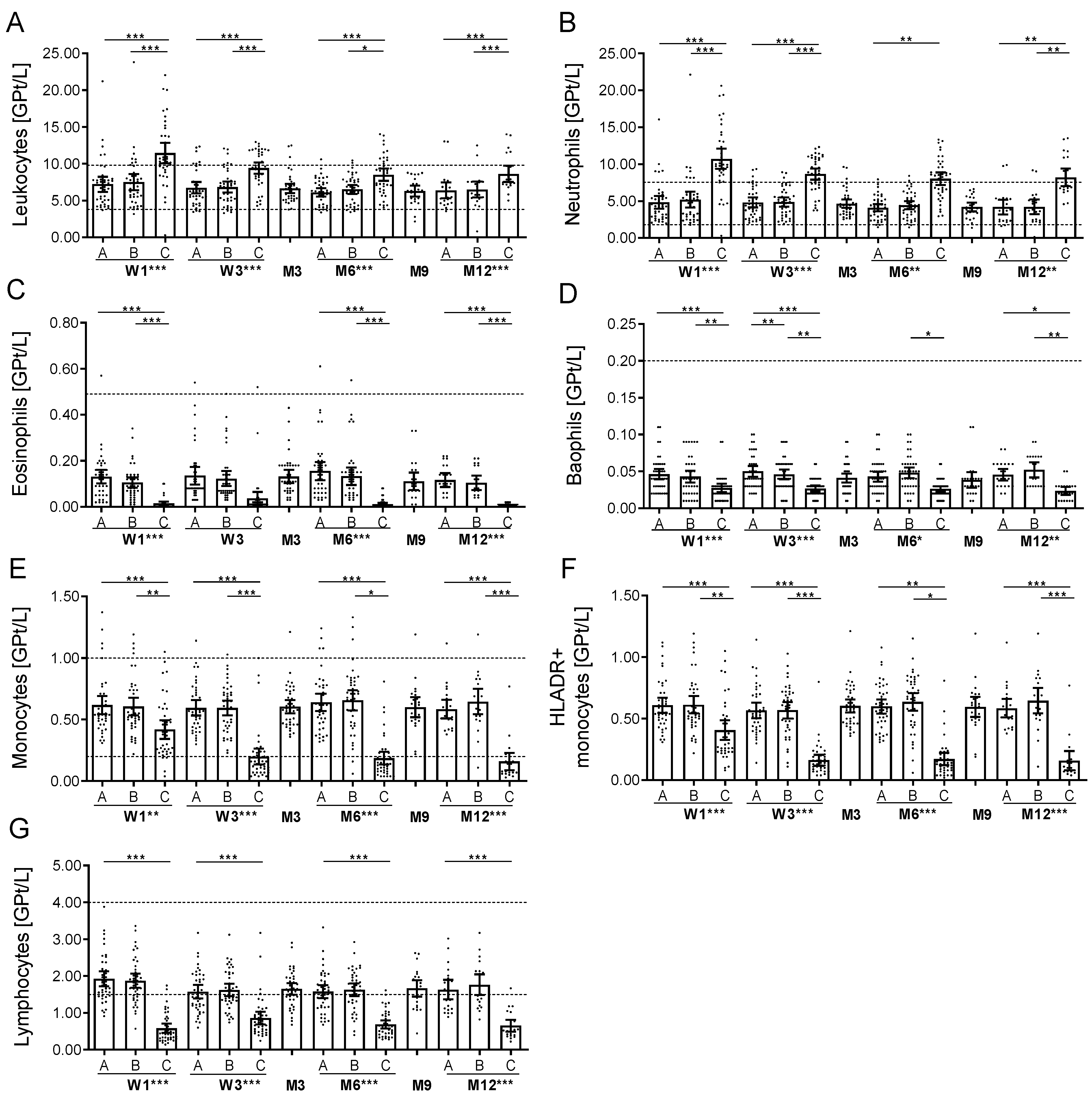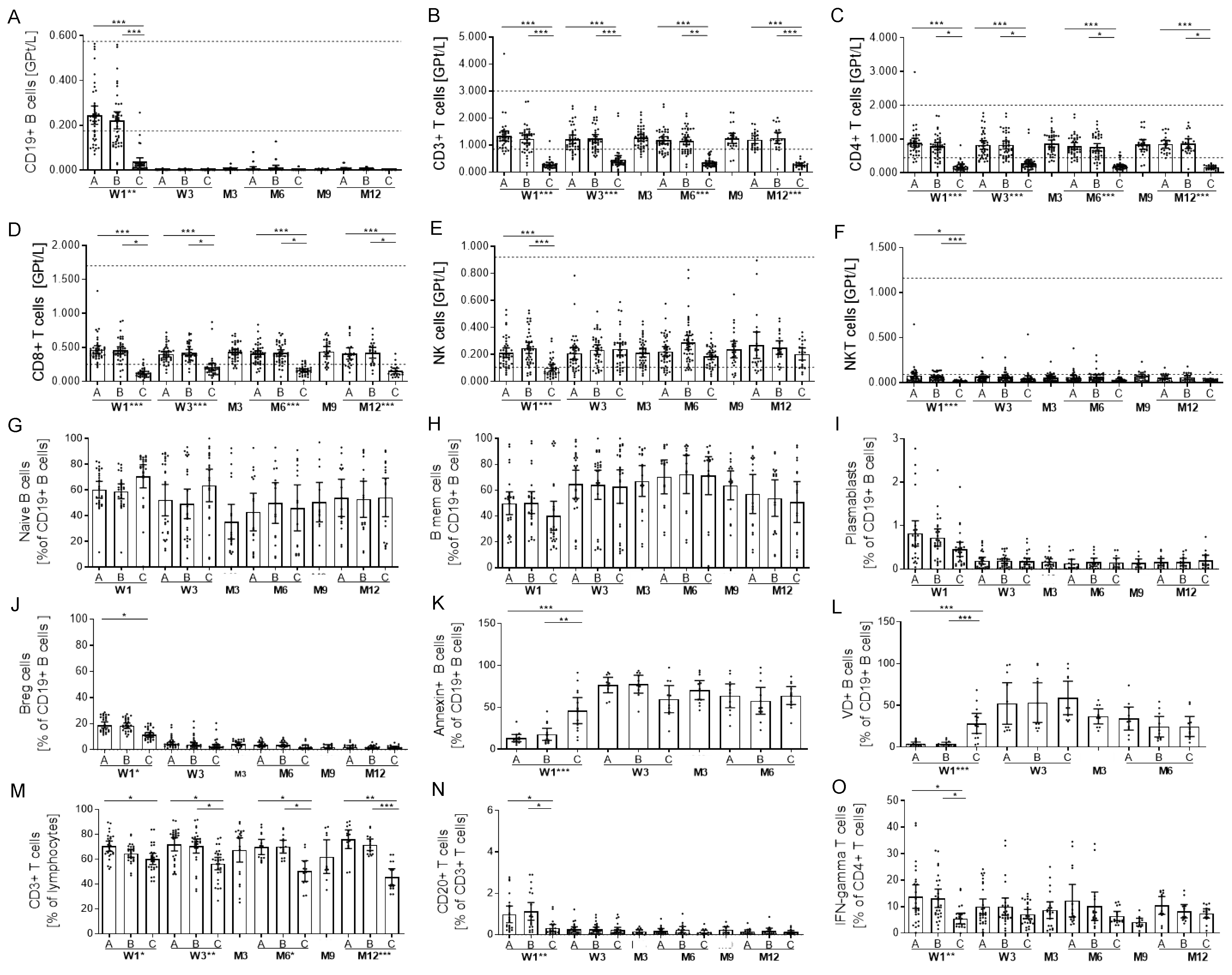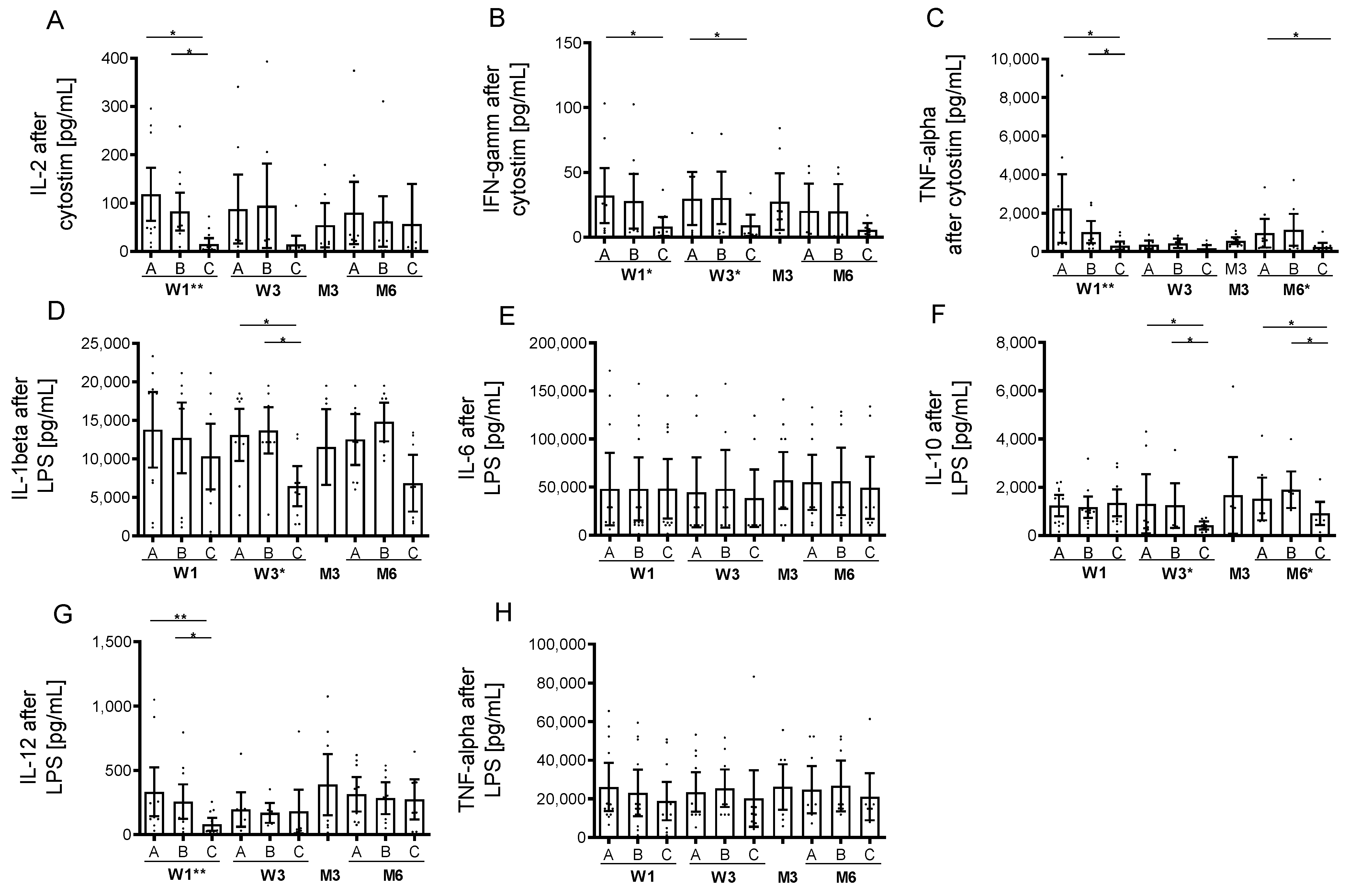Acute Effects of Ocrelizumab Infusion in Multiple Sclerosis Patients
Abstract
:1. Introduction
2. Results
2.1. Stable Vital Signs and Mild Adverse Events
2.2. Acute Effects on Complete Blood Count
2.3. Clinical Chemistry
2.4. Effects on Selective Immune Cell Subsets
2.5. Cytokine Levels and Cell Activation Level upon Stimulation
3. Discussion
4. Materials and Methods
4.1. Patients and Study Approval
4.2. OCR Infusion Protocol and Blood Sampling
4.3. Routine Blood Analysis
4.4. Immune Cell Phenotyping by Fluorescence-Activated Cell Sorting (FACS)
4.5. Cytokine Assay
4.6. Statistical Analysis
Supplementary Materials
Author Contributions
Funding
Institutional Review Board Statement
Informed Consent Statement
Data Availability Statement
Acknowledgments
Conflicts of Interest
References
- Hauser, S.L.; Bar-Or, A.; Comi, G.; Giovannoni, G.; Hartung, H.-P.; Hemmer, B.; Lublin, F.; Montalban, X.; Rammohan, K.W.; Selmaj, K.; et al. Ocrelizumab versus Interferon Beta-1a in Relapsing Multiple Sclerosis. N. Engl. J. Med. 2017, 376, 221–234. [Google Scholar] [CrossRef] [PubMed]
- Havrdová, E.; Arnold, D.L.; Bar-Or, A.; Comi, G.; Hartung, H.-P.; Kappos, L.; Lublin, F.; Selmaj, K.; Traboulsee, A.; Belachew, S.; et al. No evidence of disease activity (NEDA) analysis by epochs in patients with relapsing multiple sclerosis treated with ocrelizumab vs interferon beta-1a. Mult. Scler. J. Exp. Transl. Clin. 2018, 4, 2055217318760642. [Google Scholar] [CrossRef] [PubMed] [Green Version]
- Hauser, S.L.; Belachew, S.; Kappos, L. Ocrelizumab in Primary Progressive and Relapsing Multiple Sclerosis. N. Engl. J. Med. 2017, 376, 1694. [Google Scholar] [CrossRef]
- Montalban, X.; Hauser, S.L.; Kappos, L.; Arnold, D.L.; Bar-Or, A.; Comi, G.; de Seze, J.; Giovannoni, G.; Hartung, H.-P.; Hemmer, B.; et al. Ocrelizumab versus Placebo in Primary Progressive Multiple Sclerosis. N. Engl. J. Med. 2017, 376, 209–220. [Google Scholar] [CrossRef] [PubMed]
- Sorensen, P.S.; Blinkenberg, M. The potential role for ocrelizumab in the treatment of multiple sclerosis: Current evidence and future prospects. Ther. Adv. Neurol. Disord. 2016, 9, 44–52. [Google Scholar] [CrossRef] [Green Version]
- Syed, Y.Y. Ocrelizumab: A Review in Multiple Sclerosis. CNS Drugs 2018, 32, 883–890. [Google Scholar] [CrossRef]
- Fernández-Velasco, J.I.; Kuhle, J.; Monreal, E.; Meca-Lallana, V.; Meca-Lallana, J.; Izquierdo, G.; Gascón-Giménez, F.; de la Maza, S.S.; Walo-Delgado, P.E.; Maceski, A.; et al. Effect of Ocrelizumab in Blood Leukocytes of Patients With Primary Progressive MS. Neurol.-Neuroimmunol. Neuroinflamm. 2021, 8, e940. [Google Scholar] [CrossRef]
- Palanichamy, A.; Jahn, S.; Nickles, D.; Derstine, M.; Abounasr, A.; Hauser, S.L.; Baranzini, S.E.; Leppert, D.; Von Büdingen, H.-C. Rituximab efficiently depletes increased CD20-expressing T cells in multiple sclerosis patients. J. Immunol. 2014, 193, 580–586. [Google Scholar] [CrossRef] [Green Version]
- Novi, G.; Ivaldi, F.; Sbragia, E.; Mikulska, M.; Pesce, G.; Inglese, M.; de Rosbo, N.K.; Uccelli, A. Ocrelizumab does not impair B- and T-cell responses to primary VZV infection in a patient with MS. Neurol.-Neuroimmunol. Neuroinflamm. 2020, 7, e695. [Google Scholar] [CrossRef] [Green Version]
- Landi, D.; Grimaldi, A.; Bovis, F.; Ponzano, M.; Fantozzi, R.; Buttari, F.; Signoriello, E.; Lus, G.; Lucchini, M.; Mirabella, M.; et al. Influence of Previous Disease-Modifying Drug Exposure on T-Lymphocyte Dynamic in Patients With Multiple Sclerosis Treated With Ocrelizumab. Neurol.-Neuroimmunol. Neuroinflamm. 2022, 9, e1157. [Google Scholar] [CrossRef]
- Hauser, S.; Kappos, L.; Montalban, X.; Craveiro, L.; Chognot, C.; Hughes, R.; Koendgen, H.; Pascquarelli, N.; Pradhan, A.; Prajapati, K.; et al. Safety of Ocrelizumab in Patients With Relapsing and Primary Progressive Multiple Sclerosis. Neurology 2021, 97, e1546–e1559. [Google Scholar] [CrossRef]
- Maggi, E.; Vultaggio, A.; Matucci, A. Acute infusion reactions induced by monoclonal antibody therapy. Expert. Rev. Clin. Immunol. 2011, 7, 55–63. [Google Scholar] [CrossRef]
- Thomas, K.; Eisele, J.; Rodriguez-Leal, F.A.; Hainke, U.; Ziemssen, T. Acute effects of alemtuzumab infusion in patients with active relapsing-remitting MS. Neurol.-Neuroimmunol. Neuroinflamm. 2016, 3, e228. [Google Scholar] [CrossRef] [PubMed] [Green Version]
- European Medicines Agency. Ocrevus 300 mg Concentrate for Solution for Infusion: EU Summary of Product Characteristics. Available online: https://wwwemaeuropaeu/en/documents/product-information/ocrevus-epar-product-information_enpdf (accessed on 3 December 2021).
- Vermersch, P.; Oreja-Guevara, C.; Siva, A.; Van Wijmeersch, B.; Wiendl, H.; Wuerfel, J.; Buffels, R.; Kadner, K.; Kuenzel, T.; Comi, G.; et al. Efficacy and safety of ocrelizumab in patients with relapsing-remitting multiple sclerosis with suboptimal response to prior disease-modifying therapies: A primary analysis from the phase 3b CASTING single-arm, open-label trial. Eur. J. Neurol. Off. J. Eur. Fed. Neurol. Soc. 2022, 29, 790–801. [Google Scholar] [CrossRef]
- Lee, D.W.; Gardner, R.; Porter, D.L.; Louis, C.U.; Ahmed, N.; Jensen, M.; Grupp, S.A.; Mackall, C.L. Current concepts in the diagnosis and management of cytokine release syndrome. Blood 2014, 124, 188–195. [Google Scholar] [CrossRef] [Green Version]
- Moreau, T.; Coles, A.; Wing, M.; Isaacs, J.; Hale, G.; Waldmann, H.; Compston, A. Transient increase in symptoms associated with cytokine release in patients with multiple sclerosis. Brain A J. Neurol. 1996, 119 Pt 1, 225–237. [Google Scholar] [CrossRef] [PubMed] [Green Version]
- Moreau, T.; Coles, A.; Wing, M.; Thorpe, J.; Miller, D.; Moseley, I.; Issacs, J.; Hale, G.; Clayton, D.; Scolding, N.; et al. CAMPATH-IH in multiple sclerosis. Mult. Scler. 1996, 1, 357–365. [Google Scholar] [CrossRef] [PubMed]
- Hartung, H.-P.; Berger, T.; Bermel, R.; Brochet, B.; Carroll, W.; Holmøy, T.; Karabudak, R.; Killestein, J.; Nos, C.; Patti, F.; et al. Shorter infusion time of ocrelizumab: Results from the randomized, double-blind ENSEMBLE PLUS substudy in patients with relapsing-remitting multiple sclerosis. Mult. Scler. Relat. Disord. 2020, 46, 102492. [Google Scholar] [CrossRef]
- Gelfand, J.M.; Cree, B.; Hauser, S.L. Ocrelizumab and Other CD20(+) B-Cell-Depleting Therapies in Multiple Sclerosis. Neurotherapeutics 2017, 14, 835–841. [Google Scholar] [CrossRef] [Green Version]
- Baker, D.; MacDougall, A.; Kang, A.S.; Schmierer, K.; Giovannoni, G.; Dobson, R. CD19 B cell repopulation after ocrelizumab, alemtuzumab and cladribine: Implications for SARS-CoV-2 vaccinations in multiple sclerosis. Mult. Scler. Relat. Disord. 2022, 57, 103448. [Google Scholar] [CrossRef] [PubMed]
- Bar-Or, A.; Fawaz, L.; Fan, B.; Darlington, P.J.; Rieger, A.; Ghorayeb, C.; Calabresi, P.A.; Waubant, E.; Hauser, S.L.; Zhang, J.; et al. Abnormal B-cell cytokine responses a trigger of T-cell-mediated disease in MS? Ann. Neurol. 2010, 67, 452–461. [Google Scholar] [CrossRef] [PubMed]
- Gingele, S.; Jacobus, T.L.; Konen, F.F.; Hümmert, M.W.; Sühs, K.-W.; Schwenkenbecher, P.; Ahlbrecht, J.; Möhn, N.; Müschen, L.H.; Bönig, L.; et al. Ocrelizumab Depletes CD20(+) T Cells in Multiple Sclerosis Patients. Cells 2018, 8, 12. [Google Scholar] [CrossRef] [Green Version]
- Schuh, E.; Berer, K.; Mulazzani, M.; Feil, K.; Meinl, I.; Lahm, H.; Krane, M.; Lange, R.; Pfannes, K.; Subklewe, M.; et al. Features of Human CD3+CD20+ T Cells. J. Immunol. 2016, 197, 1111–1117. [Google Scholar] [CrossRef] [PubMed] [Green Version]
- Aufweber, E.; Jorup-Ronstrom, C.; Edner, A.; Hansson, L.O. C-reactive protein sufficient as screening test in bacterial vs. viral infections. J. Infect. 1991, 23, 216–220. [Google Scholar] [CrossRef]
- Massaro, K.S.; Costa, S.F.; Leone, C.; Chamone, D.A. Procalcitonin (PCT) and C-reactive protein (CRP) as severe systemic infection markers in febrile neutropenic adults. BMC Infect. Dis. 2007, 7, 137. [Google Scholar] [CrossRef] [Green Version]
- Kappos, L.; Li, D.; Calabresi, P.A.; O’Connor, P.; Bar-Or, A.; Barkhof, F.; Yin, M.; Leppert, D.; Glanzman, R.; Tinbergen, J.; et al. Ocrelizumab in relapsing-remitting multiple sclerosis: A phase 2, randomised, placebo-controlled, multicentre trial. Lancet 2011, 378, 1779–1787. [Google Scholar] [CrossRef]



| T0 | T1 | T2 | T3 | T4 | T5 | |
| W1 | ||||||
| BPsyst/ | 127.6 (16.2)/ | 120.2 (22.2)/ | 123.4 (13.7)/ | 124.0 (14.0)/ | 125.6 (13.0)/ | 125.5 (13.4)/ |
| BPdiast | 82.6 (10.4) | 80.3 (9.6) | 78.3 (10.5) | 79.2 (10.4) | 79.1 (11.2) | 78.2 (9.2) |
| [mmHg] | ||||||
| HR [bpm] | 78.3 (11.3) | 77.8 (14.3) | 76.7 (11.9) | 81.0 (13.8) | 84.1 (14.6) | 84.7 (14.5) |
| BT [°C] | 36.4 (0.5) | 36.5 (0.4) | 36.6 (0.3) | 36.7 (0.4) | 36.7 (0.4) | 36.6 (0.4) |
| W3 | ||||||
| BPsyst/ | 127.6 (15.2)/ | 120.7 (15.1)/ | 121.6 (14.7)/ | 123.7 (14.7)/ | 125.4 (14.6)/ | 120.8 (11.6)/ |
| BPdiast | 81.9 (10.7) | 78.5 (11.1) | 78.4 (10.7) | 79.2 (11.3) | 77.6 (11.0) | 77.3 (13.6) |
| [mmHg] | ||||||
| HR [bpm] | 78.1 (9.7) | 73.9 (10.2) | 72.6 (8.6) | 75.0 (11.5) | 79.1 (11.5) | 87.1 (11.1) |
| BT [°C] | 36.4 (0.3) | 36.5 (0.4) | 36.4 (0.4) | 36.5 (0.4) | 36.4 (0.3) | 36.5 (0.4) |
| W6 | ||||||
| BPsyst/ | 125.4 (12.0)/ | 122.0 (13.9)/ | 122.5 (15.5)/ | 122.8 (15.5)/ | 120.0 (14.6)/ | 126.0 (15.7)/ |
| BPdiast | 81.3 (8.9) | 80.2 (9.9) | 77.6 (9.4) | 77.9 (9.7) | 76.7 (10.0) | 78.6 (10.1) |
| [mmHg] | ||||||
| HR [bpm] | 78.4 (10.0) | 71.9 (10.1) | 72.7 (10.7) | 75.1 (10.7) | 76.5 (9.4) | 80.7 (11.8) |
| BT [°C] | 36.5 (0.3) | 36.5 (0.3) | 36.6 (0.3) | 36.6 (0.3) | 36.5 (0.4) | 36.6 (0.3) |
| W12 | ||||||
| BPsyst/ | 125.2 (14.0)/ | 126.3 (11.6)/ | 122.8 (10.4)/ | 125.5 (11.3)/ | 124.4 (10.5)/ | 125.0 (10.3)/ |
| BPdiast | 84.7 (10.1) | 85.0 (9.0) | 80.8 (7.7) | 82.6 (6.2) | 81.6 (7.5) | 82.0 (5.7) |
| [mmHg] | ||||||
| HR [bpm] | 76.6 (8.5) | 73.9 (8.4) | 74.6 (8.5) | 76.7 (7.3) | 77.5 (8.3) | 81.5 (7.9) |
| BT [°C] | 36.4 (0.2) | 36.5 (0.2) | 36.5 (0.2) | 36.5 (0.2) | 36.5 (0.3) | 36.4 (0.2) |
| W1 | W2 | M3 | M6 | M9 | M12 | |||||||||
|---|---|---|---|---|---|---|---|---|---|---|---|---|---|---|
| A | B | C | A | B | C | A | B | C | A | B | C | |||
| IL-1beta | 11.2 (19.1) | 10.4 (19.0) | 11.1 (18.9) | 12.3 (19.2) | 10.1 (19.1) | 9.3 (17.6) | 7.1 (14.2) | 3.8 (2.5) | 3.3 (1.5) | 3.8 (2.8) | 3.2 (1.6) | 3.2 (1.5) | 3.5 (2.3) | 3.4 (1.8) |
| IL-2 | 2.5 (2.8) | 2.3 (2.8) | 2.4 (2.6) | 4.4 (7.0) | 2.5 (2.7) | 2.5 (2.5) | 1.7 (1.4) | 1.4 (0.8) | 1.3 (0.5) | 1.7 (1.2) | 1.5 (0.9) | 1.7 (1.3) | 1.2 (0.6) | 1.5 (0.7) |
| IL-4 | 7.5 (8.7) | 6.9 (8.3) | 5.6 (8.2) | 7.5 (7.7) | 7.3 (8.7) | 5.1 (7.0) | 4.5 (6.1) | 4.1 (5.7) | 3.8 (4.7) | 3.5 (1.7) | 3.1 (4.5) | 3.7 (4.7) | 3.7 (4.3) | 3.4 (1.3) |
| IL-5 | 1.1 (0) | 1.1 (0) | 1.1 (0) | 1.1 (0) | 1.1 (0) | 1.1 (0) | 1.1 (0) | 1.1 (0) | 1.1 (0) | 1.1 (0) | 1.1 (0) | 1.1 (0) | 1.1 (0) | 1.1 (0) |
| IL-6 | 5.8 (12.0) | 7.8 (14.1) | 16.9 (20.9) | 5.1 (12.1) | 5.2 (12.2) | 4.7 (10.9) | 3.3 (3.6) | 2.7 (2.2) | 3.0 (2.5) | 2.9 (2.5) | 3.4 (3.6) | 3.6 (4.1) | 3.7 (3.9) | 3.4 (3.8) |
| IL-9 | 4.4 (6.2) | 4.4 (6.6) | 5.5 (6.5) | 6.2 (7.7) | 4.4 (5.7) | 5.0 (5.4) | 2.5 (3.0) | 2.8 (3.7) | 2.5 (2.9) | 2.8 (3.5) | 2.0 (1.4) | 3.6 (4.7) | 3.1 (4.3) | 3.1 (3.3) |
| IL-10 | 6.8 (5.9) | 6.2 (5.2) | 128.0 (132.9) | 8.5 (8.5) | 5.4 (4.3) | 21.5 (32.1) | 5.5 (3.9) | 3.4 (2.3) | 3.8 (2.0) | 28.9 (21.9) | 1.9 (2.2) | 5.8 (5.1) | 3.4 (2.1) | 23.6 (19.0) |
| IL-12 | 38.65 (54.6) | 37.3 (57.6) | 30.6 (61.3) | 44.3 (66.1) | 35.5 (58.9) | 24.8 (54.5) | 21.7 (33.4) | 13.4 (21.5) | 11.8 (17.3) | 8.6 (8.6) | 11.3 (20.1) | 13.3 (18.1) | 11.6 (17.6) | 7.5 (9.0) |
| IL-13 | 3.7 (5.1) | 3.5 (5.0) | 3.4 (5.4) | 5.0 (6.6) | 3.6 (5.0) | 3.8 (4.9) | 2.4 (3.6) | 1.7 (0.9) | 1.5 (0.8) | 1.7 (1.1) | 1.5 (0.7) | 1.9 (1.1) | 1.7 (1.0) | 1.8 (0.9) |
| IL-17 | 5.4 (6.1) | 5.2 (6.2) | 3.4 (3.3) | 8.5 (8.6) | 5.6 (5.3) | 3.6 (3.2) | 3.0 (2.5) | 2.9 (4.5) | 2.5 (3.6) | 1.6 (1.1) | 2,.4 (3.3) | 2.7 (3.6) | 2. 8 (3.5) | 1.7 (1.1) |
| IL-22 | 4.3 (6.9) | 4.3 (7.3) | 5.1 (7.3) | 5.1 (7.1) | 4.6 (6.6) | 5.0 (7.4) | 4.2 (7.2) | 3.1 (3.5) | 2.4 (2.0) | 2.5 (2.3) | 2.5 (2.7) | 2.5 (2.1) | 2.3 (1.7) | 2.1 (1.4) |
| IFN | 5.1 (7.0) | 4.4 (5.7) | 8.1 (4.4) | 5.9 (8.7) | 3.8 (5.1) | 3.6 (4.8) | 2.6 (4.1) | 2.1 (2.9) | 1.7 (1.3) | 2.1 (2.0) | 2.1 (2.5) | 1.9 (1.6) | 1.7 (1.4) | 1.8 (1.4) |
| TNF | 7.4 (2.9) | 9.7 (10.8) | 24.3 (9.9) | 6.6 (2.9) | 6.0 (2.4) | 5.3 (1.7) | 6.5 (3.0) | 5.8 (2.8) | 5.4 (1.8) | 6.3 (3.6) | 6.9 (3.9) | 6.0 (1.7) | 5.5 (1.0) | 5.8 (1.3) |
| Age, years (mean, SD) | 41.6 (10.3) |
| Female (no, %) | 28 (62.2) |
| Disease duration, years (mean, SD) | 6.6 (7.1) |
| Disease course (no, (%)) | |
| RMS | 34 (76.0) |
| PMS | 11 (24.0) |
| EDSS (mean, SD) | |
| RMS | 3.1 (1.8) |
| PMS | 4.5 (1.7) |
| Pre-treatment (no, %) | |
| none | 17 (37.8) |
| injectables | 10 (22.2) |
| fingolimod | 6 (13.3) |
| dimethylfumarate | 3 (6.7) |
| teriflunomide | 3 (6.7) |
| natalizumab | 2 (4.4) |
| daclizumab | 4 (8.9) |
Publisher’s Note: MDPI stays neutral with regard to jurisdictional claims in published maps and institutional affiliations. |
© 2022 by the authors. Licensee MDPI, Basel, Switzerland. This article is an open access article distributed under the terms and conditions of the Creative Commons Attribution (CC BY) license (https://creativecommons.org/licenses/by/4.0/).
Share and Cite
Akgün, K.; Behrens, J.; Schriefer, D.; Ziemssen, T. Acute Effects of Ocrelizumab Infusion in Multiple Sclerosis Patients. Int. J. Mol. Sci. 2022, 23, 13759. https://doi.org/10.3390/ijms232213759
Akgün K, Behrens J, Schriefer D, Ziemssen T. Acute Effects of Ocrelizumab Infusion in Multiple Sclerosis Patients. International Journal of Molecular Sciences. 2022; 23(22):13759. https://doi.org/10.3390/ijms232213759
Chicago/Turabian StyleAkgün, Katja, Johanna Behrens, Dirk Schriefer, and Tjalf Ziemssen. 2022. "Acute Effects of Ocrelizumab Infusion in Multiple Sclerosis Patients" International Journal of Molecular Sciences 23, no. 22: 13759. https://doi.org/10.3390/ijms232213759






